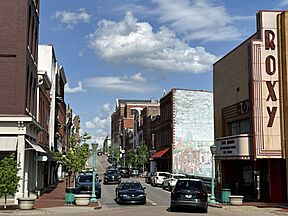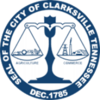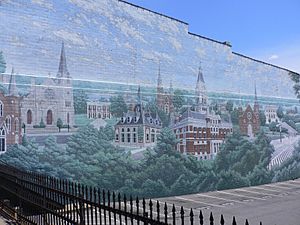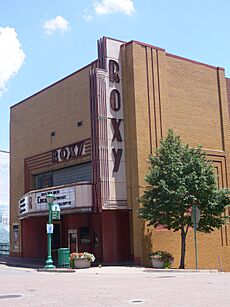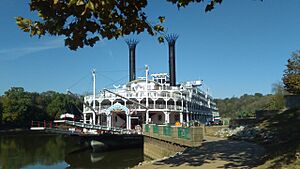Clarksville, Tennessee facts for kids
Quick facts for kids
Clarksville, Tennessee
|
|||
|---|---|---|---|
|
|
|||
|
|||
| Nicknames: | |||
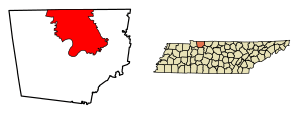
Location of Clarksville in Montgomery County, Tennessee.
|
|||
| Country | United States | ||
| State | Tennessee | ||
| County | Montgomery | ||
| Founded: | 1784 | ||
| Incorporated: | 1808 | ||
| Government | |||
| • Type | Mayor–council | ||
| Area | |||
| • City | 100.28 sq mi (259.72 km2) | ||
| • Land | 99.58 sq mi (257.91 km2) | ||
| • Water | 0.70 sq mi (1.81 km2) | ||
| Elevation | 476 ft (145 m) | ||
| Population
(2020)
|
|||
| • City | 166,722 | ||
| • Rank | US: 159th TN: 5th |
||
| • Density | 1,674.29/sq mi (646.44/km2) | ||
| • Urban | 200,947 (US: 192nd) | ||
| • Urban density | 1,776.9/sq mi (686.1/km2) | ||
| • Metro | 328,304 (US: 159th) | ||
| GDP | |||
| • Metro | $16.209 billion (2022) | ||
| Time zone | UTC−6 (CST) | ||
| • Summer (DST) | UTC−5 (CDT) | ||
| ZIP codes |
37040-37044
|
||
| Area code(s) | 931 | ||
| FIPS code | 47-15160 | ||
| GNIS feature ID | 1269467 | ||
| Website | cityofclarksville.com | ||
Clarksville is a big city in Tennessee, USA. It is the main city of Montgomery County, Tennessee. It's the fifth largest city in Tennessee, with over 166,000 people living there in 2020.
Clarksville is part of a larger area called the Clarksville metropolitan area. This area includes counties in both Tennessee and Kentucky.
The city was started in 1785 and became an official town in 1807. It was named after General George Rogers Clark. He was a hero from the American Revolutionary War. He was also the brother of William Clark from the famous Lewis and Clark Expedition.
Clarksville is home to Austin Peay State University. It also has The Leaf-Chronicle, which is Tennessee's oldest newspaper. Close by is Fort Campbell, a big United States Army base. This base is where the 101st Airborne Division is located. It's about 10 miles (16 km) from downtown Clarksville.
Contents
Clarksville's History
Early Settlers and Founding
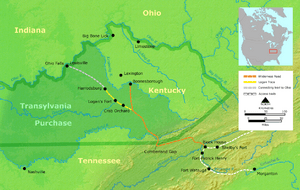
The area where Clarksville is now was first explored in 1768. Early explorers noted a rock bluff called Red Paint Hill. This spot was where the Cumberland River and Red River meet.
Between 1771 and 1775, John Montgomery and Kasper Mansker visited the area. In 1771, James Robertson led families from North Carolina to settle nearby. These settlers formed the Watauga Association in 1772. This was an early independent government.
In 1775, a land buyer named Richard Henderson bought a huge amount of land from the Cherokee tribe. This land included what is now Clarksville. This purchase was against the rules of the time.
In 1779, more settlers came to the area. Some, like Moses Renfroe and his family, settled near the Red River. Clarksville was planned as a town for soldiers who fought in the American Revolutionary War. The government didn't have money to pay them, so they offered land instead.
On January 16, 1784, a plan was made to create the town of Clarksville. It was named after General George Rogers Clark. The town was officially founded on December 29, 1785. It was designed with a grid of streets on a hill to protect against floods.
The tobacco trade grew quickly in the area. In 1789, Clarksville became an official place to inspect tobacco. When Tennessee became a state in 1796, the area around Clarksville became Montgomery County.
Growth in the 1800s
Clarksville grew fast. By 1806, the town started a school called the Rural Academy. In 1819, it had 22 stores. In 1820, steamboats began using the Cumberland River. They brought goods like coffee and fabric to the city. Clarksville sent out flour, tobacco, and cotton to other cities.
In 1829, the first bridge was built over the Red River. Railroad service came to Clarksville in 1859. By the start of the American Civil War, the city and county had 20,000 people. Many farms in the area used enslaved African Americans to grow tobacco.
The Civil War and After
In 1861, Clarksville and Montgomery County voted to join the Confederate States of America. Both sides thought Clarksville was important because of its rivers and railroads. The city had three Confederate army camps. One was Fort Defiance, Tennessee, which watched over the rivers.
In 1862, Union troops and gunboats came down the Cumberland River. They captured Clarksville on February 17, 1862. The Confederate soldiers had left before the Union arrived. The Union took control of the city and its newspaper. Many enslaved people found freedom in Clarksville and joined the Union Army. The 16th United States Colored Infantry regiment was formed in Clarksville in 1863.
After the war, the city began to rebuild. In 1878, a huge fire destroyed 15 acres (60,000 m²) of downtown Clarksville. This included the courthouse and many old buildings. But the city rebuilt itself.
The 1900s and Beyond
In 1913, the Lillian Theater opened. It was later renamed the Roxy. During World War I, many locals joined the army. In 1919, the First Women's Bank of Tennessee was started by Mrs. Frank J. Runyon. This allowed women to manage their own money.
The 1920s brought more growth. A bus line started in 1922. In 1927, Austin Peay Normal School was founded. It later became Austin Peay State University.
During World War II, Camp Campbell (now Fort Campbell) was built near the city in 1942. This army base brought many new people and jobs to Clarksville.
Since 1980, Clarksville's population has more than doubled. This is partly because the city has grown by adding nearby communities. Clarksville is now one of the fastest-growing cities in Tennessee.
Natural Disasters
Clarksville has faced some natural disasters:
- In January 1999, a strong tornado hit downtown Clarksville.
- In May 2010, the city was affected by floods.
- In February 2018, another tornado hit the east side of Clarksville.
- In December 2023, a powerful tornado caused damage and sadly, four deaths in North Clarksville.
- In May 2024, the city had severe weather with some flooding and hail. A smaller tornado also touched down nearby.
Clarksville's Location and Weather
Clarksville covers about 95.5 square miles (247 km²). Most of this is land, with a small amount of water. It is located on the edge of the Highland Rim, about 45 miles (72 km) northwest of Nashville.
The climate in Clarksville is humid subtropical. This means it has hot summers and cold winters. But the weather can change quickly because it's between the warm Gulf of Mexico and the colder Midwest. Snow is common in winter, but usually not very deep. Rain falls throughout the year.
| Climate data for Clarksville WWTP, Tennessee (1991–2020 normals, extremes 1890–present) | |||||||||||||
|---|---|---|---|---|---|---|---|---|---|---|---|---|---|
| Month | Jan | Feb | Mar | Apr | May | Jun | Jul | Aug | Sep | Oct | Nov | Dec | Year |
| Record high °F (°C) | 82 (28) |
82 (28) |
94 (34) |
94 (34) |
99 (37) |
109 (43) |
110 (43) |
109 (43) |
112 (44) |
98 (37) |
88 (31) |
80 (27) |
112 (44) |
| Mean maximum °F (°C) | 68 (20) |
73 (23) |
81 (27) |
87 (31) |
90 (32) |
95 (35) |
97 (36) |
97 (36) |
94 (34) |
87 (31) |
79 (26) |
70 (21) |
99 (37) |
| Mean daily maximum °F (°C) | 46.8 (8.2) |
51.6 (10.9) |
61.2 (16.2) |
71.8 (22.1) |
79.4 (26.3) |
86.6 (30.3) |
89.9 (32.2) |
89.6 (32.0) |
83.6 (28.7) |
72.3 (22.4) |
59.7 (15.4) |
50.1 (10.1) |
70.2 (21.2) |
| Daily mean °F (°C) | 37.3 (2.9) |
41.1 (5.1) |
49.6 (9.8) |
59.4 (15.2) |
68.1 (20.1) |
75.8 (24.3) |
79.5 (26.4) |
78.5 (25.8) |
71.7 (22.1) |
60.0 (15.6) |
48.4 (9.1) |
40.6 (4.8) |
59.2 (15.1) |
| Mean daily minimum °F (°C) | 27.8 (−2.3) |
30.6 (−0.8) |
38.0 (3.3) |
47.0 (8.3) |
56.8 (13.8) |
65.0 (18.3) |
69.0 (20.6) |
67.4 (19.7) |
59.8 (15.4) |
47.7 (8.7) |
37.1 (2.8) |
31.1 (−0.5) |
48.1 (8.9) |
| Mean minimum °F (°C) | 9 (−13) |
14 (−10) |
22 (−6) |
32 (0) |
44 (7) |
53 (12) |
60 (16) |
58 (14) |
45 (7) |
33 (1) |
23 (−5) |
15 (−9) |
7 (−14) |
| Record low °F (°C) | −20 (−29) |
−14 (−26) |
0 (−18) |
21 (−6) |
32 (0) |
42 (6) |
47 (8) |
44 (7) |
29 (−2) |
20 (−7) |
−2 (−19) |
−12 (−24) |
−20 (−29) |
| Average precipitation inches (mm) | 4.03 (102) |
4.51 (115) |
4.78 (121) |
4.97 (126) |
5.59 (142) |
4.65 (118) |
4.59 (117) |
3.69 (94) |
3.35 (85) |
4.31 (109) |
4.11 (104) |
4.92 (125) |
53.50 (1,359) |
| Average snowfall inches (cm) | 3.0 (7.6) |
2.4 (6.1) |
1.0 (2.5) |
0.0 (0.0) |
0.0 (0.0) |
0.0 (0.0) |
0.0 (0.0) |
0.0 (0.0) |
0.0 (0.0) |
0.0 (0.0) |
0.2 (0.51) |
0.5 (1.3) |
7.2 (18) |
| Average precipitation days (≥ 0.01 in) | 11.9 | 11.2 | 12.3 | 11.9 | 12.1 | 10.8 | 10.1 | 9.4 | 8.7 | 9.1 | 10.5 | 12.4 | 130.4 |
| Average snowy days (≥ 0.1 in) | 3.0 | 2.4 | 1.0 | 0.0 | 0.0 | 0.0 | 0.0 | 0.0 | 0.0 | 0.0 | 0.2 | 0.5 | 7.8 |
| Source 1: NOAA | |||||||||||||
| Source 2: Weather.com | |||||||||||||
People of Clarksville
| Historical population | |||
|---|---|---|---|
| Census | Pop. | %± | |
| 1870 | 3,200 | — | |
| 1880 | 3,880 | 21.3% | |
| 1890 | 7,924 | 104.2% | |
| 1900 | 9,431 | 19.0% | |
| 1910 | 8,548 | −9.4% | |
| 1920 | 8,110 | −5.1% | |
| 1930 | 9,242 | 14.0% | |
| 1940 | 11,831 | 28.0% | |
| 1950 | 16,246 | 37.3% | |
| 1960 | 22,021 | 35.5% | |
| 1970 | 31,719 | 44.0% | |
| 1980 | 54,777 | 72.7% | |
| 1990 | 75,494 | 37.8% | |
| 2000 | 103,455 | 37.0% | |
| 2010 | 132,929 | 28.5% | |
| 2020 | 166,722 | 25.4% | |
| 2023 (est.) | 180,716 | 35.9% | |
| Sources: | |||
Population Makeup
Clarksville is a diverse city. Here's a look at the different groups of people living there, based on the 2020 census:
| Race / Ethnicity (NH = Non-Hispanic) | Pop 2000 | Pop 2010 | Pop 2020 | % 2000 | % 2010 | % 2020 |
|---|---|---|---|---|---|---|
| White alone (NH) | 67,562 | 81,165 | 89,596 | 65.31% | 61.06% | 53.74% |
| Black or African American alone (NH) | 23,692 | 29,872 | 39,567 | 22.90% | 22.47% | 23.73% |
| Native American or Alaska Native alone (NH) | 486 | 616 | 582 | 0.47% | 0.46% | 0.35% |
| Asian alone (NH) | 2,189 | 3,011 | 4,003 | 2.12% | 2.27% | 2.40% |
| Pacific Islander alone (NH) | 248 | 586 | 812 | 0.24% | 0.44% | 0.49% |
| Some Other Race alone (NH) | 320 | 219 | 938 | 0.31% | 0.16% | 0.56% |
| Mixed race or Multiracial (NH) | 2,717 | 5,158 | 11,553 | 2.63% | 3.88% | 6.93% |
| Hispanic or Latino (any race) | 6,241 | 12,302 | 19,671 | 6.03% | 9.25% | 11.80% |
| Total | 103,455 | 132,929 | 166,722 | 100.00% | 100.00% | 100.00% |
In 2020, there were 166,722 people living in Clarksville. There were 58,985 households and 39,595 families.
Clarksville's Economy
Clarksville has many important businesses and employers. These include:
- Amazon (a large distribution center)
- American Standard
- Bridgestone Metalpha USA
- Convergys Corporation
- FedEx (a distribution center)
- Fort Campbell (a major army base)
- Hankook
- Jostens (printing and publishing)
- LG
- SPX Corporation (metal forge)
- Trane (Clarksville's biggest private employer)
Fun Things to See and Do
Clarksville has many interesting places to visit:
- Roxy Theatre: A historic theater downtown.
- F&M Bank Arena: Home to Austin Peay's basketball teams.
- Governor's Square Mall: A popular shopping center.
- Clarksville City Arboretum: A place with many different trees.
- Customs House Museum and Cultural Center: The second largest museum in Tennessee.
- L & N Train Station: A restored old train station downtown.
- Wilma Rudolph statue: Honors an amazing Olympic athlete.
- Dunbar Cave: A cool cave to explore.
- Fortera Stadium: Where Austin Peay's football team plays.
- Cumberland River: A beautiful river that runs through the city.
- Liberty Park and Marina: A park by the river with a marina.
- Fort Defiance: A Civil War fort with great views of the rivers.
Sports in Clarksville
Clarksville has been home to several Minor League Baseball teams. These teams played in the early 1900s. Some of their names were the Clarksville Villagers, Grays, and Volunteers. Later, the city also hosted the Clarksville Coyotes in the 1990s.
Learning in Clarksville
Colleges and Universities
- Austin Peay State University
- Daymar Institute
- Nashville State Community College
- North Tennessee Bible Institute
Public Schools
Clarksville and Montgomery County share one school system. It's called the Clarksville-Montgomery County School System. It has 39 public schools for about 37,666 students. This includes eight high schools, seven middle schools, and 24 elementary schools.
Here are the public high schools (grades 9–12):
- Clarksville High School
- Kenwood High School
- Kirkwood High School
- Montgomery Central High School
- Northeast High School
- Northwest High School
- Rossview High School
- West Creek High School
Some parts of Fort Campbell use schools run by the Department of Defense Education Activity (DoDEA).
Private Schools
Clarksville also has private schools:
- Clarksville Academy (for students from pre-kindergarten to 12th grade)
- Immaculate Conception School (grades K–8)
- Little Scholars Montessori (Preschool–5)
- Clarksville Christian School
Getting Around Clarksville
Main Roads and Highways
Major roads that go through Clarksville include:
- U.S. Route 41A
- U.S. Route 79
- Interstate 24
- State Route 12
- State Route 13
- State Route 48
- State Route 76
- State Route 374
Air Travel
For big flights, people use Nashville International Airport. Clarksville also has a smaller airport called Outlaw Field. It's about 10 miles (16 km) north of downtown. This airport is used for private and corporate flights. It also has a pilot training school.
Clarksville used to have a small private airfield called Cobb Field, but it is no longer used for planes.
Bus System
The Clarksville Transit System has 10 bus routes. Buses run from Monday to Saturday.
Famous People from Clarksville
- Roy Acuff – Country music star
- James E. Bailey – U.S. Senator
- Willie Blount – Former governor of Tennessee
- Nate Colbert – MLB baseball player
- Dorothy Dix – Famous newspaper advice columnist
- Harry Galbreath – Football player
- Jeff Gooch – Former football player
- Ernest William Goodpasture – Doctor and pathologist
- Caroline Gordon – Novelist
- Jimi Hendrix – Famous guitarist and singer
- Trenton Hassell – NBA basketball player
- Cave Johnson – U.S. Postmaster General
- Micah Johnson – NFL linebacker
- Dorothy Jordan – Film actress
- Horace Harmon Lurton – U.S. Supreme Court Justice
- Shawn Marion – Olympic and professional basketball player
- Isaac Murphy – Former governor of Arkansas
- Wayne Pace – CFO of Time Warner
- Austin Peay – Governor of Tennessee; Austin Peay State University is named after him.
- Chonda Pierce – Christian comedian
- Key Pittman – U.S. Senator
- Alex Poythress – NBA basketball player
- DJ Pryor – Comedian and actor
- Wilma Rudolph – First female athlete to win three gold medals in one Olympics.
- Clarence Saunders – Founder of Piggly Wiggly stores.
- George Sherrill – Baseball player
- Rachel Smith – Miss USA (2007)
- James Storm – Professional wrestler
- Pat Summitt – Famous women's basketball coach
- Frank Sutton – Actor (Sergeant Vince Carter in Gomer Pyle, USMC)
- Allen Tate – Poet
- Mageina Tovah – Actress
- Robert Penn Warren – First United States Poet Laureate
- William Westmoreland – Military commander
- Clarence Cameron White – Musician
- James "Fly" Williams – Basketball player
- Ryne Harper – Baseball player
- Ricky Lumpkin - NFL player
- Scotty Kilmer - Car Mechanic and YouTube Personality
Clarksville's Nicknames
Clarksville has a few nicknames:
- The Queen City
- Queen of the Cumberland
- Gateway to the New South
In 2008, the city adopted "Tennessee's Top Spot!" as its official brand nickname.
Sister City
See also
 In Spanish: Clarksville (Tennessee) para niños
In Spanish: Clarksville (Tennessee) para niños


